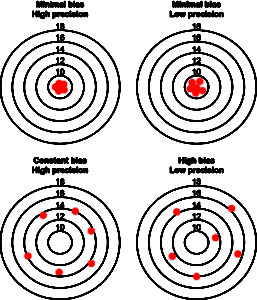The target model of bias and precision: Bias (expressed as the absolute or percentage difference between the instrument result and the actual result) gives you a measure of result accuracy, whereas the coefficient of variation (CV or the SD divided by the mean) gives you a measure of assay precision. The higher the CV, the lower the precision. We aim for CVs <5% for high precision. Top left panel: Minimal bias and high precision is when an instrument provides the expected result (e.g. 5.0) on different runs consistently (e.g. 5.1, 4.9, 5.0, 5.1, 5.0, 4.9 = 0 bias, 2% CV). To right panel: Minimal bias and lower precision is when the instrument provides the expected result with less consistency (e.g. 5.0, 4.7, 5.3, 4.6, 5.2, 5.0 = 0 bias, 6% CV). Lower left panel: Constant bias (in this case positive) with high precision means that the instrument provides a result that is different from the actual result but it does so consistently (e.g. 14.0, 14.2, 14.4, 13.8, 14.2, 13.9 = 9 bias, 2% CV). Top right panel: High bias (in this case positive) with low precision means that the instrument is not providing the expected result and the results between runs are inconsistent (e.g. 14.2, 16.4, 11.8, 15.5, 14, 13.4 = 9 bias and 11% CV).

